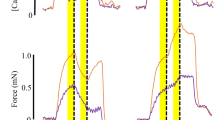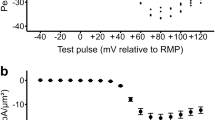Abstract
THE role of external Ca2+ in excitation–contraction coupling has been controversial since Sandow1 put forward the idea that contraction is initiated by an influx of Ca2+ on depolarisation. In the very thin lamellae (1 µm) of Branchiostoma myotome muscle ‘Ca2+-free’ solutions with 1 mM EGTA block twitches completely2,3. It was concluded that the Ca2+ influx during the action potential directly activates the myofilaments2. In frog muscle twitches remain unchanged in 1 mM EGTA2− (refs 4, 5). To ensure that [Ca2+] is sufficiently reduced in the narrow transverse tubular (T) system Barrett and Barrett6 raised the Ca2+ buffer concentration to 80 mM and observed that action potentials were no longer followed by twitches. In this letter we demonstrate that some further changes in the composition of the external fluids result in the restoration of contractions in both Branchiostoma and frog muscle indicating that a Ca2+ influx is not necessary for the initiation of contraction.
This is a preview of subscription content, access via your institution
Access options
Subscribe to this journal
Receive 51 print issues and online access
$199.00 per year
only $3.90 per issue
Buy this article
- Purchase on Springer Link
- Instant access to full article PDF
Prices may be subject to local taxes which are calculated during checkout
Similar content being viewed by others
References
Sandow, A. Yale J. biol. Med. 25, 176–201 (1952).
Hagiwara, S., Henkart, M. P. & Kidokoro, Y. J. Physiol., Lond. 219, 233–251 (1971).
Grocki, K. & Melzer, W. Pflügers Arch. ges. Physiol. Suppl. 373, R59 (1978).
Armstrong, C. M., Bezanilla, F. M. & Horowicz, P. Biochim. biophys. Acta 267, 605–608 (1972).
Lüttgau, H. C. & Spiecker, W. Pflügers Arch. ges. Physiol. Suppl. 373, R59 (1978); J. Physiol., Lond. (in the press).
Barrett, J. N. & Barrett, E. F. Science 200, 1270–1272 (1978).
Hodgkin, A. L. & Horowicz, P. J. Physiol., Lond. 148, 127–160 (1969).
Dörrscheidt-Käfer, M. Pflügers Arch. ges. Physiol. 362, 33–41 (1976).
Portzehl, H., Caldwell, P. C. & Rüegg, J. C. Biochim. biophys. Acta 79, 581–591 (1964).
Sillén, L. G. & Martell, A. E. Stability Constants of Metal Ion Complexes (Chem. Soc. Spec. Publ. 17 and 25, 1964 and 1971).
Endo, M. Physiol. Rev. 57, 71–108 (1977).
Hodgkin, A. L. & Horowicz, P. J. Physiol., Lond. 153, 404–412 (1960).
Miledi, R., Parker, I. & Schalow, G. Proc. R. Soc. B 198, 201–210 (1977).
Schneider, M. F. & Chandler, W. K. Nature 242, 244–246 (1973).
Author information
Authors and Affiliations
Rights and permissions
About this article
Cite this article
SPIECKER, W., MELZER, W. & LÜTTGAU, H. Extracellular Ca2+ and excitation–contraction coupling. Nature 280, 158–160 (1979). https://doi.org/10.1038/280158a0
Received:
Accepted:
Published:
Issue Date:
DOI: https://doi.org/10.1038/280158a0
This article is cited by
-
Hans-Christoph Lüttgau 20 July 1926–5 November 2017
Journal of Muscle Research and Cell Motility (2017)
-
Dispositions of junctional feet in muscles of invertebrates
Journal of Muscle Research and Cell Motility (1992)
-
Feet, bridges, and pillars in triad junctions of mammalian skeletal muscle: Their possible relationship to calcium buffers in terminal cisternae and T-tubules and to excitation-contraction coupling
The Journal of Membrane Biology (1989)
-
Suppression of charge movement in frog skeletal muscle by D600
Journal of Muscle Research and Cell Motility (1987)
-
Purification of the putative calcium channel from skeletal muscle with the aid of [3H]-nimodipine binding
Naunyn-Schmiedeberg's Archives of Pharmacology (1983)
Comments
By submitting a comment you agree to abide by our Terms and Community Guidelines. If you find something abusive or that does not comply with our terms or guidelines please flag it as inappropriate.



